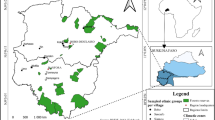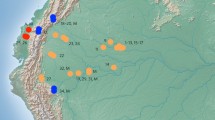Abstract
Plant families differ greatly with regard to their usefulness to humans. Within families there are also large differences in the usefulness between species; some are used for many different purposes, while most are used for few or no purposes. Which ones and to what extent species are used often varies between areas and cultural groups. To better understand variation in speciesȁ9 usefulness we studied the use of different palm species (Arecaceae) among two socio-cultural groups (one indigenous and one colonist group of mixed ethnic descent) living in the same area. We used regression and correlation analyses to determine to what degree use is related to ecological and morphological characteristics, to geographical differences in abundance, and to peopleȁ9s perceptions of speciesȁ9 availability. We found that abundance and height were the most important characteristics related to use, possibly due to the effect of height and abundance on salience, search time, and (for height) suitability for different purposes. Abundance was most important for palm heart extraction, probably due to the opportunistic nature of this activity. There was no difference between socio-cultural groups with regard to the relationship between palm abundance and use, but abundance seemed to be more decisive for people who used moderate amounts of palms. Finally, it was seen that peopleȁ9s estimates of palm abundance were not related to our measurements of abundance, which may be due to use of different spatial scales in evaluating abundance and to the subjective nature of terms such as “rare” and “abundant”.
Similar content being viewed by others
References
Balick, M. J. (1984). Ethnobotany of palms in the Neotropics. Advances in Economic Botany, 1, 9–23.
Balslev, H. (2002). Palmas austroecuatorianas. In Z. Aguirre, J. E. Madsen, E. Cotton, & H. Balslev (Eds.), Botánica Austroecuatoriana (pp. 107–135). Abya Yala: Quito, Ecuador.
Balslev, H., & Øllgaard, B. 2002, Mapa de vegetación del sur de Ecuador. In: Z. Aguirre, J. E. Madsen, E. Cotton, & H. Balslev (Eds.), Botánica Austroecuatoriana, (pp. 51–64). Abya Yala: Quito, Ecuador.
Begon, M., Harper, J. L., & Townsend, C. R. (1990). Ecology—individuals, populations and communities, Boston: Blackwell Scientific Publications.
Begossi, A. (1992). The use of Optimal Foraging Theory in the understanding of fishing strategies: A case from Sepetiba Bay (Rio de Janeiro State, Brazil). Human Ecology, 20, 463–475.
Bennett, B. C., Baker, M. A., & Gómez Andrade, P. (2002). Ethnobotany of the Shuar of Eastern Ecuador. Advances in Economic Botany, 14, 1–299.
Borchsenius, F., Borgtoft Pedersen, H., & Balslev, H. (1998). Manual to the Palms of Ecuador, Aarhus, Denmark: Aarhus University Press.
Borchsenius, F., & Skov, F. (1997). Ecological amplitudes of Ecuadorian palms. Palms (formerly Principes), 41(1), 179–183.
Byg, A., & Balslev, H. (2003). Palm heart extraction in Zahamena, eastern Madagascar. Principes, 47(1), 37–44.
Byg, A., & Balslev, H. (2004). Factors affecting local knowledge of palms in Nangaritza valley in south-eastern Ecuador. Journal of Ethnobiology, 24(2), 255–278.
Campos, M. T., & Ehringhaus, C. (2003). Plant virtues are in the eyes of the beholders: A comparison of known palm uses among indigenous and folk communities of southwestern Amazon. Economic Botany, 57(3): 324–344.
Descola, P. (1994). In the society of nature. Cambridge: Cambridge University Press.
Garibaldi, A., & Turner, N. (2004). Cultural keystone species: Implications for ecological conservation and restoration. Ecology and Society, 9(3), 1.
Hellier, A., Newton, A.C., & Ochoa Gaona, S. (1999). Use of indigenous knowledge for rapidly assessing trends in biodiversity: A case study from Chiapas, Mexico. Biodiversity and Conservation, 8, 869–889.
Henderson, A. (1995). The palms of the Amazon, New York: Oxford University Press.
Henderson, A., Galeano, G., & Bernal, R. (1995). Field guide to the palms of the Americas. Princeton: Princeton University Press.
Holmgren, P., Holmgren, N. H., & Barnett, L.C. (Eds.). (1990). The herbaria of the World . Index Herbariorum. New York: New York Botanical Garden.
Jain, S. K. (2000). Human aspects of plant diversity. Economic Botany, 54(4), 459–470.
Johns, T. (1994). Ambivalence to the palatability factors in wild food plants. In N. L. Etkin, (Ed.), Eating on the wild side (pp. 46–61). Tucson: Arizona University Press.
Lawrence, A., Phillips, O. L., Reategui Ismodes, A., Lopez, M., Rose, S., Wood, D., & Farfan, A. J. (2005) Local values for harvested plants in Madre de Dios, Peru: towards a more contextualised interpretation of quantitative ethnobotanical data. Biodiversity and Conservation, 14, 45–79.
Moerman, D. E., Pemberton, R. W., Kiefer, D., & Berlin, B. (1999). A comparative analysis of five medicinal floras. Journal of Ethnobiology, 19(1), 49–67.
Nazarea, V. D. (1999). Lenses and latitudes in landscapes and lifescapes. In V. D. Nazarea (Ed.), Ethnoecology—situated knowledge/located lives (pp. 91–106). Tucson: University of Arizona.
Neill, D. (2001). Botanical Exploration of the Cordillerea del Cóndor Region. Ecuador: Missouri Botanical Garden.
Neill, D. A. (1999). Vegetation. In: P. M. Jørgensen & S. Léon-Yánez (Eds.), Catalogue of the vascular plants of Ecuador (pp. 13–25). St. Louis: Missouri Botanical Garden Press.
Neill, D. A., & Jørgensen, P. M. (1999). Climates, In: P. M. Jørgensen & S. Léon-Yánez (Eds.), Catalogue of the vascular plants of Ecuador (pp. 8–13). St. Louis: Missouri Botanical Garden Press.
Nolan, J. M. (2001). Pursuing the fruits of knowledge: Cognitive ethnobotany in Missouriȁ9s Little Dixie. Journal of Ethnobiology, 21(2), 29–51.
Nyhus, P. J., Sumianto, & Tilson, R. (2003). Wildlife knowledge among migrants in southern Sumatra, Indonesia: Implications for conservation. Environmental Conservation, 30(2), 192–199.
Palacios, W. (1997). Botany and landscape of the Río Nangaritza basin, In T. S. Schulenberg & K.␣Awbrey (Eds.), The Cordillera del Cóndor Region of Ecuador and Peru: A biological assessment (pp. 37–44). Washington, D.C., Conservation International. 7.
Phillips, O., & Gentry, A. H. (1993). The useful plants of Tambopata, Peru: II. Additional hypothesis testing in quantitative ethnobotany. Economic Botany, 47(1), 33–43.
Ruokolainen, K., & Vormisto, J. (2000). The most wiedespread Amazonian palms tend to be tall and habitat generalists. Basic and Applied Ecology, 1, 97–108.
Schulenberg, T. S. & Awbrey, K. (Eds.) (1997). The Cordillera del Cóndor Region of Ecuador and Peru: A Biological Assessment, Rapid Assessment Program Working paper no. 7. Washington, D.C., Conservation International.
Turner, N. J. (1988). “The importance of a rose”: Evaluating the cultural significance of plants in Thompson and Lillooet Interior Salish. American Anthropologist, 90, 272–290.
Wallace, A. R. (1971). Palm trees of the Amazon. Lawrence, Kansas: Coronado Press.
Zeleznik, W. S., & Bennett, I. M. (1991). Assumption Validity in Human Optimal Foraging: The Barí Hunters of Venezuela as a Test Case. Human Ecology, 19(4), 499–508.
Acknowledgements
We thank all the staff from the Herbario Reinaldo Espinosa, Universidad Nacional, in Loja, Ecuador, for their kind and efficient help with our fieldwork. We also thank the inhabitants in the visited villages, who shared their knowledge of palms with us. Funding for this work was obtained from the Research Council for Development Research (Danida grant 91050 to AB), the European Union (Marie Curie Fellowship to JV) and the Danish Natural Science Research Council (21-01-0617 and 21-02-0522 to HB).
Author information
Authors and Affiliations
Corresponding author
Rights and permissions
About this article
Cite this article
Byg, A., Vormisto, J. & Balslev, H. Using the useful: characteristics of used palms in south-eastern Ecuador. Environ Dev Sustain 8, 495–506 (2006). https://doi.org/10.1007/s10668-006-9051-6
Received:
Accepted:
Published:
Issue Date:
DOI: https://doi.org/10.1007/s10668-006-9051-6




